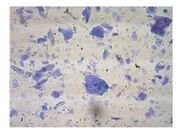Barium copper silicate
Jump to navigation
Jump to search


Han pule, PPL 400x, field of view 0.25mm photograph by Ruth Siddall Link
Description
A general name for either a blue (BaCuSi4O10) or purple (BaCuSi2O6) pigment found in paints and ceramic glazes on Chinese artifacts from the Han dynasty, 208 BCE - 220 CE. Han Blue is chemically and structurally analogous to the naturally occurring mineral effenbergite. BOoth the blue and purple have particularly distinctive optical properties and are readily identified by PLM and XRD.
Synonyms and Related Terms
Han blue; Han purple; Chinese blue; Chinese purple; silicato de bario y cobre (Esp.); silicato di rame e bario (It.)
Physical and Chemical Properties
- The purple is destroyed by dilute acids with some effervescence.
- The blue is acid-resistant.
- Both colors are strongly birefringent under crossed polars.
- Refractive Index = 1.72-1.74 (purple); 1.593-1.633 (blue)
Resources and Citations
- Ruth Siddall, 'Mineral Pigments in Archaeology: Their Analysis and the Range of Available Materials' Minerals Vol 8, p. 201 (2018). Link
- E.West FitzHugh, L.Zycherman "A Purple Barium Copper Silicate Pigment from Early China" Studies in Conservation 37:145-154, 1992.
- E.West FitzHugh, L.Zycherman "An Early Man-made Blue Pigment from China - Barium Copper Silicate" Studies in Conservation 28:15-23, 1983.
- Nicholas Eastaugh, Valentine Walsh, Tracey Chaplin, Ruth Siddall, Pigment Compendium, Elsevier Butterworth-Heinemann, Oxford, 2004